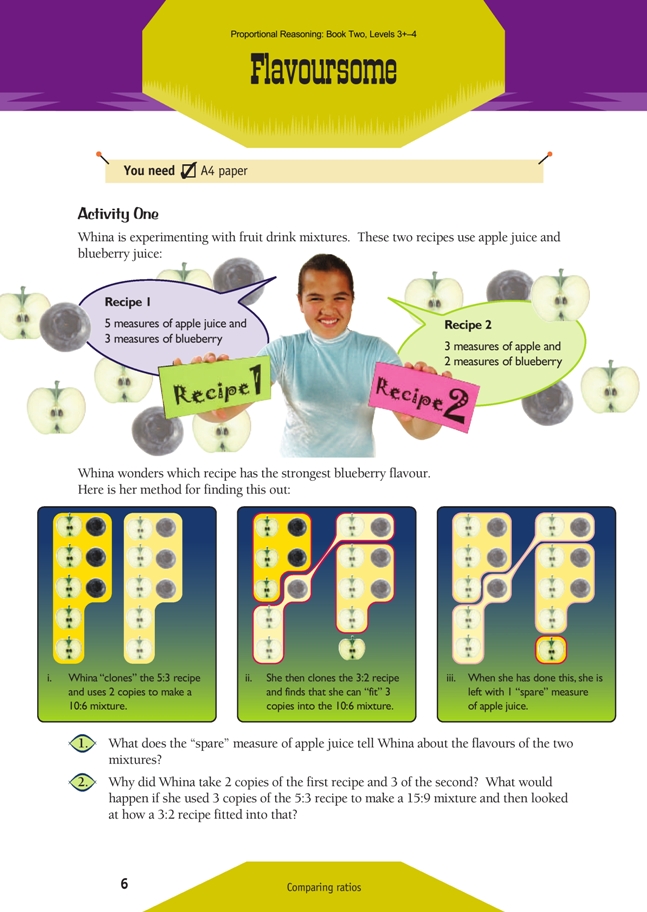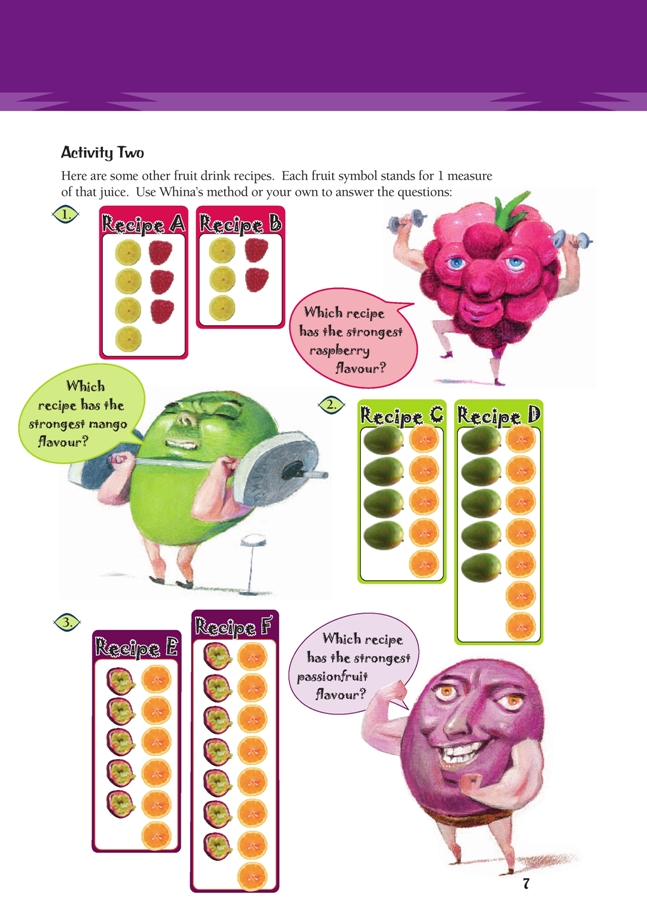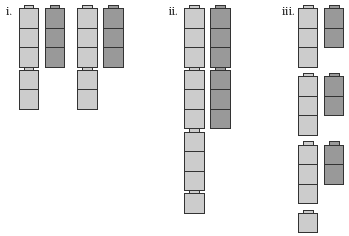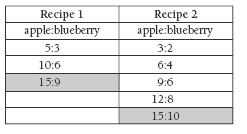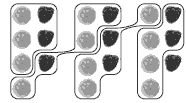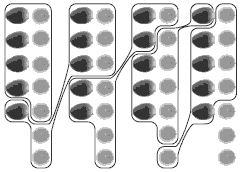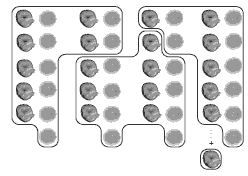This is a level 5 number activity from the Figure It Out series. It relates to Stage 8 of the Number Framework.
A PDF of the student activity is included.
Click on the image to enlarge it. Click again to close. Download PDF (1502 KB)
compare ratios
Use this activity to:
• help students consolidate and apply their knowledge of equivalent fractions (stage 7)
• develop confidence in students who are beginning to use advanced proportional strategies (stage 8).
A4 paper
Activity One
In this activity, students learn how to use “cloning”: an interesting way of comparing two ratios. Cloning (alternatively “duplicating” or “replicating”) can easily be modelled using multilink cubes as materials, as in the following illustration. A different colour is needed for each part of the ratio:
i. The 5:3 recipe is cloned, and 2 copies made; ii. The 2 copies are combined to make a 10:6 mix; iii. The 10:6 mix is used to make three copies of the 3:2 recipe, with 1 measure of apple juice left over.
Have students clone the ratios and record the results:
Ensure that they connect the numbers in the lists with the situation shown in Whina’s method.
Students need to be able to make sense of question 1 if they are to be able to do Activity Two. The extra apple juice shows that recipe 1 has a stronger apple flavour and conversely that recipe 2 has a stronger blueberry flavour.
Question 2 is designed to highlight the fact that Whina kept cloning both recipes until she found a common amount of either apple or blueberry. Without this, she couldn’t compare the ratios. In question 1, she matched the amounts of blueberry; in question 2, she matches the amount of apple:
Question 1 shows that recipe 1 has a stronger apple flavour. Question 2 shows that recipe 2 has a stronger blueberry flavour. It is important that your students understand that these are just different ways of stating the same conclusion.
Activity Two
Emphasise the phrase “or your own” to encourage your students to use both cloning (with or without multilink cubes) and another strategy to answer these questions.
A second strategy could be to write the proportion of the named flavour in each recipe as a fraction and then to compare the two fractions with the help of a common denominator. Ask “What proportions of recipe A and recipe B are raspberry?” “How can we compare these two fractions?”
In question 1, recipe A is 3/7 raspberry and recipe B is 2/5 raspberry. Using 35 as a suitable common denominator, we can write these two equations: 3/7 x 5/5 = 15/35 and 2/5 x 7/7 = 14/35. We can now see that 3/7 is greater than 2/5, which shows that recipe A has the stronger raspberry flavour.
Answers to Activities
Activity One
1. The spare measure tells Whina that the 5:3 recipe has proportionally more apple juice in it than the 3:2 recipe. This means that the 5:3 recipe will have a stronger apple taste and the 3:2 recipe will have a stronger blueberry taste.
2. Whina wants to match either the amounts of apple juice or the amounts of blueberry juice. By doubling the 5:3 recipe and trebling the 3:2 recipe, she makes the blueberry match (6 measures). If she takes 3 copies of the 5:3 recipe (as suggested) and 5 copies of the 3:2 recipe, she will match the amounts of apple juice. (She will
then discover that 3 copies of the first recipe [15:9] will “fit” into the 5 copies of the second recipe [15:10], leaving one “spare” measure of blueberry juice.)
Activity Two
1. If recipe A is cloned 3 times, recipe B will “fit into” it 4 times, with 1 measure of raspberry left over. This means that recipe A has a stronger raspberry flavour than recipe B.
2. Recipe D can be cloned 4 times to give a 20:28 mixture. Cloning recipe C 5 times gives 20:25; when the second mixture is fitted into the first, 3 measures of orange are left over. This shows that recipe C has a stronger mango flavour than recipe D.
3. Recipe E could be cloned 4 times to give 20:24 and recipe F cloned twice to give 14:16. A third clone of recipe F could be obtained if there were just 1 more measure of passionfruit, meaning that recipe F must have a stronger passionfruit flavour than recipe E.
